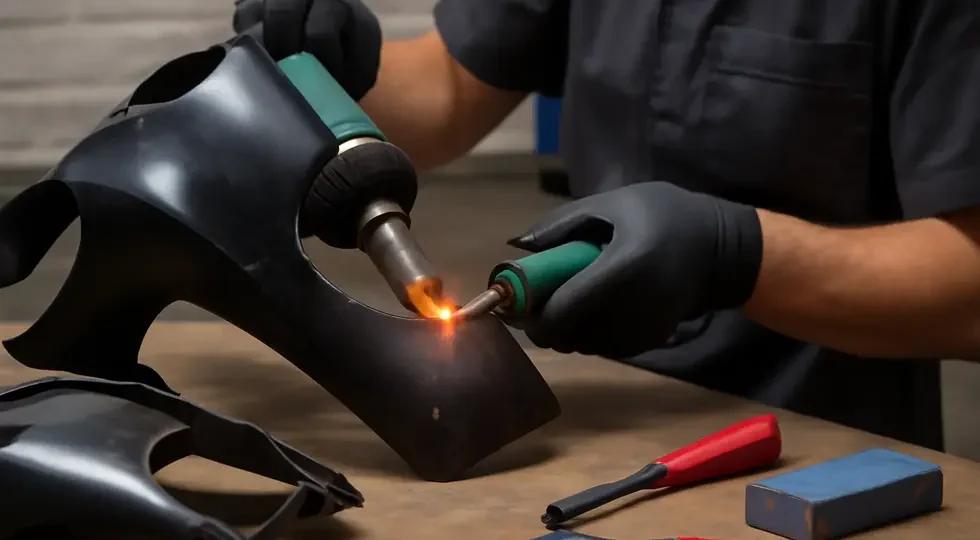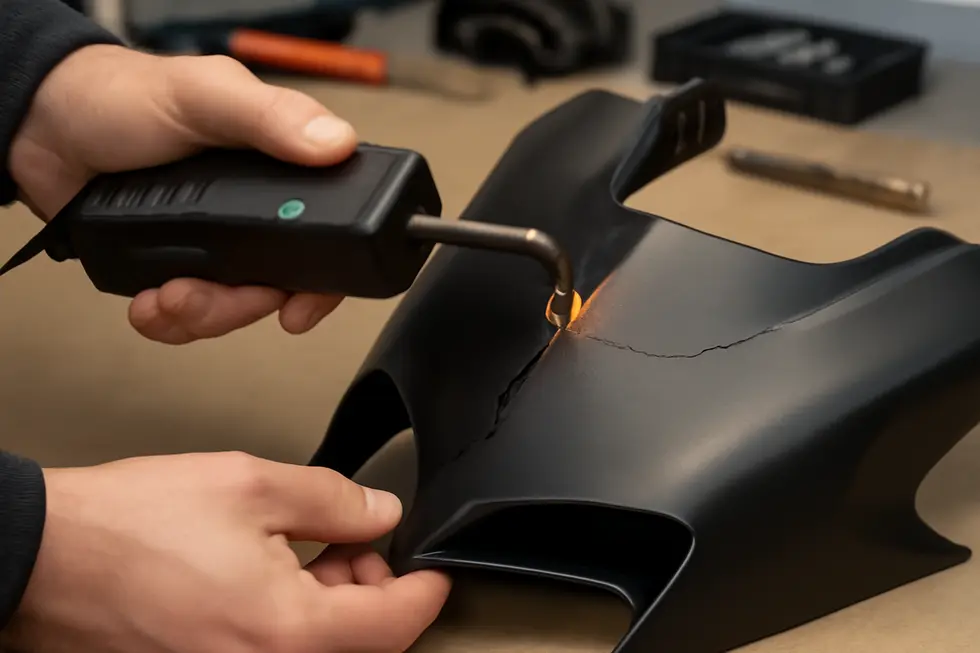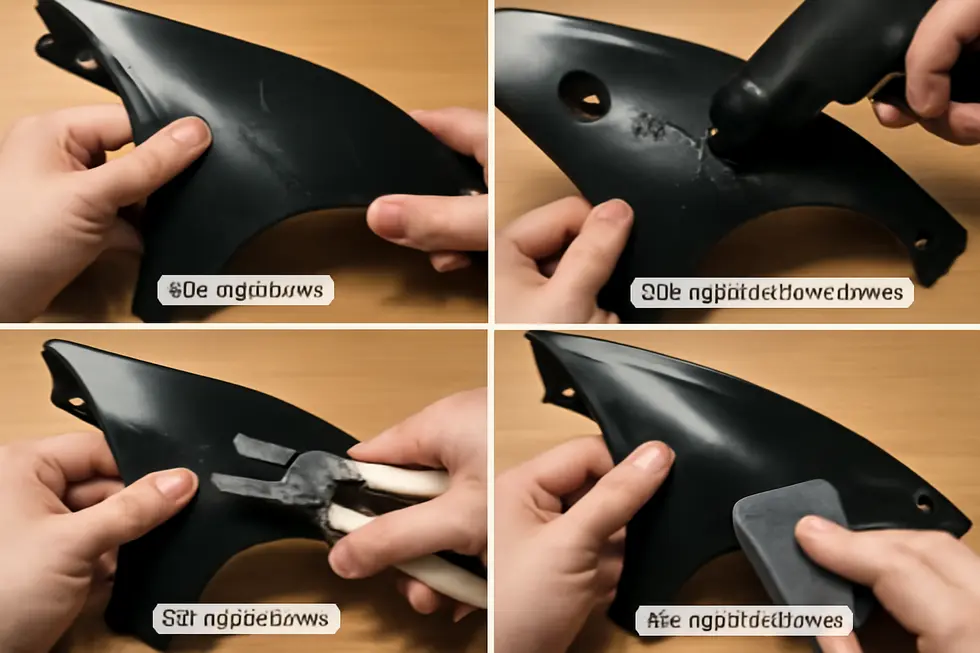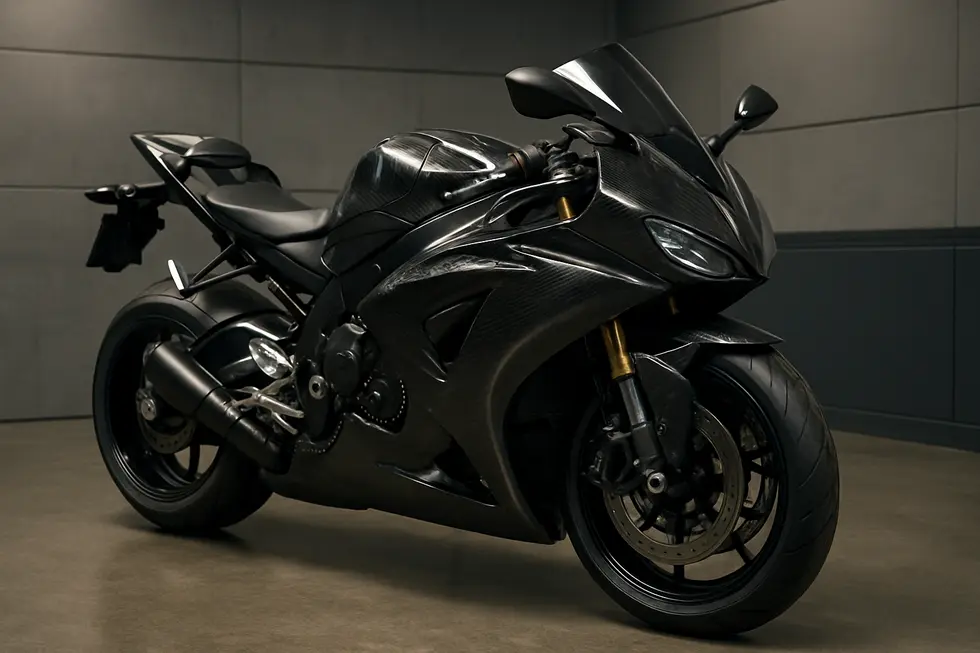Mastering Motorcycle Fairing Repair: ABS Plastic Welding and Restoration
October 14, 2025 | by summitfairings

Introduction
Motorcycle fairings made from ABS plastic are a staple in the industry due to their durability and cost-effectiveness, yet cracks and damage can compromise both aesthetics and structural integrity. For business owners operating repair shops or service centers, understanding how to proficiently restore these ABS plastic parts offers a competitive edge. This comprehensive guide navigates the intricacies of repairing ABS fairings with advanced plastic welding techniques that deliver strength exceeding traditional adhesives. It breaks down the step-by-step repair process, ensuring not only durable fixes but a polished finish that maintains your customers’ satisfaction and repeat business. Additionally, it highlights the advantageous material properties of ABS plastic, reinforcing why this plastic remains ideal for motorcycle fairings. Each chapter builds on the last to equip businesses with actionable knowledge to enhance repair quality and operational efficiency.
Tables of Contents
Chapter 1: Plastic Welding Techniques for Motorcycle Fairing Repair ABS Plastic
- Integrating Advanced Plastic Welding Methods and Tools for Durable ABS Motorcycle Fairing Repairs
- Economic Advantages and Market Evolution Driven by Plastic Welding in ABS Motorcycle Fairing Repairs
- Navigating Global Challenges: How Geopolitical and Regulatory Factors Influence Plastic Welding for ABS Fairings
- Enhancing Sustainability and Community Through ABS Plastic Welding Repairs
Chapter 2: Step-by-Step Process for Motorcycle Fairing Repair ABS Plastic
- Essential Cleaning and Surface Preparation Techniques for Durable ABS Fairing Repairs
- Mastering Plastic Welding and Adhesive Techniques for Durable ABS Motorcycle Fairing Repairs
- Mastering Surface Preparation: Expert Sanding, Filling, and Priming Techniques for ABS Motorcycle Fairings
- Mastering Surface Refinement: Painting, Polishing, and Protective Finishing for ABS Motorcycle Fairings
Chapter 3: Material Properties and Advantages of ABS Plastic in Motorcycle Fairing Repair
- Harnessing ABS Plastic’s Unique Strengths for Durable and Repairable Motorcycle Fairings
- Cost Efficiency and Durability: The Economic Strength of ABS Plastic in Fairing Repairs
- Navigating Global Dynamics: Geopolitical Influences on ABS Plastic Availability for Motorcycle Fairing Repairs
- Balancing Rider Safety, Sustainability, and Performance: The Societal and Environmental Role of ABS Plastic in Motorcycle Fairings
Chapter 1: Plastic Welding Techniques for Motorcycle Fairing Repair ABS Plastic

1. Integrating Advanced Plastic Welding Methods and Tools for Durable ABS Motorcycle Fairing Repairs
Plastic welding has revolutionized the repair of ABS motorcycle fairings by offering a fusion process that restores both strength and aesthetics beyond what adhesives can achieve. Among the array of welding methods, hot air welding, ultrasonic welding, and hot staple welding stand out for their distinct applications and benefits. Hot air welding utilizes a controlled stream of heated air to soften both the fairing surface and ABS filler rods, creating a seamless bond especially effective for wider cracks. Ultrasonic welding, though largely industrial, generates intense heat through friction from high-frequency vibrations, providing rapid and strong joints but requiring specialized equipment less accessible in typical repair settings.
The most practical and popular choice for on-site fairing repairs is hot staple welding. This technique employs electrically heated staples which are driven into the plastic surrounding a crack, melting the ABS internally and fusing the fractured edges with reinforced strength. The staples embed discreetly behind the repair line, maintaining the outer visual clarity of the panel. After cooling, any excess staple is trimmed and the surface is sanded smooth to prepare for polishing.
Tools supporting these methods range from hot air guns with adjustable temperature controls to precision clamps ensuring accurate alignment during welding. Hot staple kits often include various staple sizes and safety features to prevent overheating. The repair process begins with thorough cleaning and precise alignment, followed by stapling or welding along the crack, trimming excess material, and meticulous sanding with fine grits (1500–2000) to smooth imperfections. Final polishing restores the glossy finish, combining soap cleaning, wet sanding, plastic polish, and protective coatings.
This integrated approach to ABS plastic welding strikes a balance of durability and appearance, making it an indispensable method for restoring factory motorcycle fairings. For comprehensive insights on restoring surfaces and finishing techniques, explore detailed guidance available from specialized motorcycle fairing buffing tutorials.
2. Economic Advantages and Market Evolution Driven by Plastic Welding in ABS Motorcycle Fairing Repairs
Plastic welding has revolutionized the economics of repairing ABS motorcycle fairings by providing a robust, cost-efficient alternative to replacement. Damaged fairings—once expensive and time-consuming to swap—can now be precisely repaired using heat-based methods that fuse the plastic edges back to near-original strength. This significantly reduces material costs for riders, especially those with older or rare models where OEM replacements may be prohibitively expensive or difficult to obtain.
Moreover, the streamlined plastic welding process demands less labor time than traditional fixes, enhancing repair shop efficiency and lowering the overall service price. Many motorcycle enthusiasts also embrace these techniques for DIY repairs, expanding access to affordable maintenance and fostering a culture of sustainability through part reuse. Such practices reduce plastic waste and lessen demand for new manufacturing, aligning repair economics with environmental responsibility.
On a market level, the rise of plastic welding tools and techniques has sparked growth in specialized repair services that attract budget-conscious customers. This trend encourages service diversification, compelling OEM manufacturers to reconsider their sales strategies and explore value-added repair certifications or customized offerings. Consumer behavior is shifting accordingly, with riders increasingly informed by accessible tutorials and resources to attempt repairs or seek weld-based services rather than defaulting to part replacement.
In parallel, insurers may recognize repaired fairings as structurally sound, potentially influencing premiums and coverage decisions. Reliable repairing methods also enhance the resale value of used motorcycles, supporting healthier secondary markets. These interconnected economic and market dynamics underscore plastic welding’s growing role not only as a technical solution but as a transformative element within motorcycle maintenance and industry practices.
For more on the evolution of motorcycle fairings and repair solutions, explore this comprehensive resource.
3. Navigating Global Challenges: How Geopolitical and Regulatory Factors Influence Plastic Welding for ABS Fairings
The effectiveness of plastic welding in repairing ABS motorcycle fairings extends beyond technical skill and tooling—it is deeply shaped by geopolitical dynamics and regulatory frameworks. Trade policies, tariffs, and import restrictions can significantly affect the availability and price of welding equipment and repair materials. For example, restrictive tariffs may increase costs, limiting access to high-quality tools or forcing repair shops to rely on less suitable alternatives, which can compromise repair quality.
Additionally, regional regulations play a crucial role in determining which plastic welding methods are permissible or practical. Environmental laws frequently restrict the use of certain chemicals or adhesives, encouraging the adoption of welding techniques that produce fewer emissions or waste. Safety standards also mandate protective procedures during welding to minimize health risks, influencing how and where repairs can be conducted.
These geopolitical and regulatory variations create a complex landscape for those performing ABS plastic repairs on motorcycle fairings. Political instability or shifting trade alliances may disrupt supply chains, affecting the consistency and reliability of necessary materials. Meanwhile, environmental mandates push the industry toward greener, more sustainable practices, though these can also raise costs or require updated training and equipment.
Understanding these factors is essential for professionals to deliver durable, compliant repairs that maintain the structural integrity of ABS fairings. For comprehensive guidance on preserving your fairing’s finish after plastic welding repairs, including proper polishing methods and material compatibility, the detailed tutorials available at Summit Fairings offer valuable insights.
4. Enhancing Sustainability and Community Through ABS Plastic Welding Repairs
Plastic welding techniques for repairing ABS motorcycle fairings provide significant societal advantages by promoting sustainability and strengthening community ties. This repair method reduces the need for complete replacements, effectively cutting down plastic waste and limiting the environmental footprint of manufacturing new fairing components. By enabling durable, precise fixes, plastic welding extends the service life of ABS fairings, which are otherwise prone to landfill disposal after cracks or damage. This extension conserves resources and supports circular economy principles, helping reduce raw material extraction and lowering waste management pressures.
Beyond environmental benefits, plastic welding fosters a culture of collaboration among motorcycle enthusiasts and repair professionals. Sharing repair knowledge encourages a community-driven mindset focused on reuse and repair rather than disposal. Riders learn to maintain their equipment responsibly, which builds social bonds grounded in environmental stewardship. This collective engagement nurtures ongoing interest in maintenance skills, strengthening communal ties around sustainable practices.
The combined effect of these factors results in cost savings for owners and a reduction in plastic consumption. This practical approach balances economic and ecological concerns while empowering riders to take an active role in the care and longevity of their motorcycles. For further insights on the impact and techniques of plastic fairing repairs, explore resources such as the extensive guides available through motorcycle fairing specialists and repair centers.
For additional information on affordable and quality fairing options that complement repair strategies, visit the Summit Fairings blog.
Chapter 2: Step-by-Step Process for Motorcycle Fairing Repair ABS Plastic

1. Essential Cleaning and Surface Preparation Techniques for Durable ABS Fairing Repairs
Effective cleaning and surface preparation form the cornerstone of successful motorcycle fairing repairs on ABS plastic. The process begins with gently washing the fairing using mild soap and soft cloths or sponges to lift away dirt, grease, and grime without compromising the plastic’s finish. This initial step is vital to prevent any contaminants from undermining the adhesion of repair materials or surface treatments.
Once clean, the fairing must be dried completely and carefully inspected for oxidation, dullness, or damage. Identifying these imperfections shapes the subsequent refinements needed. A critical phase follows: wet sanding. Using progressively finer grit sandpapers—ranging from coarser to around 1500–2000 grit—wet sanding removes surface oxidation and minor blemishes while smoothing the fairing uniformly. It is important to maintain a gentle and even pressure to safeguard the ABS plastic’s integrity.
After sanding, the surface must be thoroughly rinsed and dried again to eliminate all dust and residue that might interfere with bonding or polishing. If deeper scratches or imperfections remain, applying a touch-up filler or paint and then re-sanding ensures a seamlessly smooth canvas.
Finally, the surface is polished using specialized plastic polish and gentle rubbing to restore clarity and shine. High-speed buffing is avoided to prevent heat damage. A protective layer of wax or ceramic coating seals the repair, defending against UV rays and environmental wear, while enhancing the fairing’s gloss and durability. These meticulous cleaning and preparation steps fundamentally enable a robust, visually flawless repair on ABS motorcycle fairings.
For further in-depth insights and polishing tutorials, exploring the resources at Summit Fairings can provide valuable guidance.
2. Mastering Plastic Welding and Adhesive Techniques for Durable ABS Motorcycle Fairing Repairs
Repairing ABS plastic motorcycle fairings demands precision and care to restore both strength and appearance. Central to this process is plastic welding, a technique that fuses cracked or broken parts by melting the material edges together, forming a bond that rivals the fairing’s original rigidity. Before welding, thorough cleaning removes dirt and oils that could weaken the joint, while wet sanding with fine grit paper (1500–2000 grit) smooths imperfections and ensures an even surface for welding or adhesive application.
For welding, heated staples or specialized tools are used to carefully melt along the crack, aligning edges perfectly for a seamless join. Excess welding material is then smoothed to blend the repair with the surrounding areas. When welding isn’t viable, high-quality plastic adhesives designed specifically for ABS offer a reliable alternative—these require rigorously clean, dry surfaces and proper curing to achieve a strong hold.
After structural repairs, refinishing restores the fairing’s glossy finish. This involves meticulous polishing with plastic compounds and a final protective layer such as wax or ceramic coating to guard against UV damage and wear. Avoiding excessive heat or high-speed tools during repair prevents warping, helping maintain the fairing’s original shape.
By combining careful surface preparation, precise plastic welding, and thoughtful finishing, this approach achieves robust, long-lasting repairs that preserve the fairing’s integrity and aesthetic. For expanded insights on polishing techniques and restoring finish, explore detailed expert resources on buffing motorcycle fairings available through specialized guides.
3. Mastering Surface Preparation: Expert Sanding, Filling, and Priming Techniques for ABS Motorcycle Fairings
Successfully repairing ABS motorcycle fairings extends beyond welding cracked plastic—it demands meticulous surface preparation to achieve a seamless, durable finish ready for painting. The process begins with thorough cleaning to remove dirt, grease, and old residues that could interfere with adhesion. Sanding the damaged area follows, starting with medium grit sandpapers around 180–220 grit to smooth out cracks, scratches, and uneven edges. Progressively finer wet sanding, up to 1500–2000 grit, refines the surface to a sleek, even texture ideal for subsequent steps.
Once sanded, any gouges or fissures must be filled with a plastic-compatible filler tailored for ABS materials. Even application and full curing of this filler ensure the repair area becomes flush with the surrounding surface. Careful sanding of the filler smooths away imperfections, blending repairs seamlessly to restore the fairing’s original contours.
Priming the prepared area is pivotal for paint adhesion and longevity. Employing a primer specifically formulated for ABS plastics, thin, even coats are applied and allowed to dry. Light sanding between coats with 600–800 grit paper maintains smoothness while promoting strong primer bonds. This primed surface should be spotless and dust-free to facilitate flawless paint application.
These integrated steps of cleaning, abrasive refinement, filling, and priming create the foundation for a professional-quality finish that resists wear and environmental stress. For detailed guidance on polishing and buffing this prepared surface to restore factory-like shine, consult specialized tutorials that emphasize gentle wet sanding and proper buffing methods. Exploring resources like the comprehensive guides at Summit Fairings offers valuable insights into achieving impeccable results throughout the repair journey.
4. Mastering Surface Refinement: Painting, Polishing, and Protective Finishing for ABS Motorcycle Fairings
After successfully repairing ABS plastic motorcycle fairings, the next crucial phase is restoring their original appearance and durability through meticulous painting, polishing, and finishing. Proper surface preparation begins by cleaning and sanding the repaired area with fine-grit sandpaper to ensure a smooth base that promotes excellent paint adhesion. Choosing a primer specifically designed for ABS plastic lays the foundation for long-lasting paint application. When applying paint, selecting acrylic or urethane-based formulas compatible with ABS plastic is essential to prevent chemical damage and peeling. Multiple thin coats should be sprayed evenly, allowing sufficient drying time between layers, which minimizes runs and achieves a consistent, factory-quality finish.
Polishing follows painting to refine the surface and enhance gloss. Starting with a cutting compound removes oxidation, scratches, and minor surface flaws by leveling the plastic. This is carefully succeeded by medium and fine finishing polishes that progressively eliminate micro-scratches and residual haze, resulting in a deep, vibrant shine. Using polishes and pads formulated for plastics avoids heat buildup or deformation, and testing in an inconspicuous spot is recommended before full application. Once polishing is complete, residual residues are wiped clean with isopropyl alcohol, preparing the surface for protective treatments.
Applying a wax or sealant made for plastic surfaces adds a durable layer of protection, guarding against environmental effects like UV exposure and moisture. These finishes boost the fairing’s resilience, preserve the polished sheen, and simplify future maintenance. This methodical approach ensures that the repaired ABS fairing not only regains its original visual appeal but also maintains lasting strength and weather resistance. For further detailed techniques on achieving flawless buffing and surface care on motorcycle plastics, explore comprehensive tutorials from Summit Fairings.
Chapter 3: Material Properties and Advantages of ABS Plastic in Motorcycle Fairing Repair

1. Harnessing ABS Plastic’s Unique Strengths for Durable and Repairable Motorcycle Fairings
ABS plastic stands out as a top choice for motorcycle fairings due to its remarkable blend of durability, flexibility, and ease of repair. Engineered for impact resistance, ABS absorbs shocks from minor collisions and road vibrations without shattering, making it ideal for components subjected to harsh riding conditions. Its lightweight nature also contributes to enhanced motorcycle performance by reducing overall weight without compromising strength. Moreover, ABS’s thermal stability ensures it withstands the heat generated near the engine and from prolonged sun exposure, preserving the integrity of the fairing over time.
Repairing ABS fairings involves technologies that capitalize on the material’s thermoplastic characteristics. Plastic welding—especially methods using heat to fuse cracked edges—restores the part’s structural strength close to factory conditions. Unlike glues, this approach bonds the plastic molecules, ensuring longevity and resilience in the repaired area. Following structural repair, ABS’s smooth surface finish accepts sanding and polishing very well, which is crucial to seamlessly blend repairs into the original aesthetics. Proper use of plastic-compatible polishes and careful buffing preserve the surface without risks of melting or scratching.
These qualities collectively make ABS plastic a highly practical and cost-effective material for fairing maintenance. Riders benefit not only from resilient protective parts but also from the material’s adaptability to precise and lasting repair techniques. For further insights into preserving ABS fairings’ surface quality post-repair, the expert guidance available at Summit Fairings offers valuable tips on buffing and finishing to maintain a showroom shine.
Explore more about maintaining and restoring motorcycle fairings at Summit Fairings blog.
2. Cost Efficiency and Durability: The Economic Strength of ABS Plastic in Fairing Repairs
The economic advantages of ABS plastic in motorcycle fairing repairs stem from its blend of affordability, durability, and straightforward maintenance. ABS is widely chosen for factory motorcycle fairings because it combines lightweight impact resistance with a cost-effective production process, making it less expensive than alternatives like fiberglass or carbon fiber. This affordability extends beyond manufacturing, as ABS fairings often reduce the overall financial burden on riders and manufacturers by limiting the frequency and complexity of repairs.
ABS’s resilience to minor impacts minimizes damage from everyday use or small accidents, thereby decreasing the need for costly replacements. When repairs are needed, its thermoplastic nature allows techniques such as plastic welding or hot staple repairs that restore structural integrity without expensive specialized skills or materials. Furthermore, the ability to carefully buff and polish ABS fairings helps restore their appearance while preserving durability, unlike more brittle materials that require full panel swaps.
This ease of repair shortens downtime for riders and lowers labor costs, contributing to better economic outcomes. The widespread availability of ABS replacement parts and repair kits also supports competitive pricing in the aftermarket, offering riders accessible options. While higher-end materials like carbon fiber appeal to performance enthusiasts, ABS remains the practical and budget-friendly choice for everyday motorcycles, balancing cost, toughness, and repairability.
For those seeking comprehensive advice on maintaining and restoring ABS fairings, exploring detailed guides on DIY buffing and protection techniques can enhance repair outcomes and extend the life of your plastic fairings. Such resources complement the practical value ABS provides in everyday motorcycle care, underscoring its economic benefits beyond initial cost savings.
3. Navigating Global Dynamics: Geopolitical Influences on ABS Plastic Availability for Motorcycle Fairing Repairs
The global availability and cost of ABS plastic—central to motorcycle fairing repair—are shaped by complex geopolitical forces. ABS manufacturing and supply involve vast international networks spanning chemical producers, manufacturing hubs, and trade channels, all sensitive to shifts in political and economic landscapes. Trade tensions and tariffs imposed by key producing countries can raise costs and constrain access to ABS raw materials and molded fairing components. These barriers ripple across repair industries reliant on imported parts, affecting pricing and supply consistency.
Environmental regulations further impact ABS production. Increasingly stringent policies in manufacturing nations elevate operational expenses or restrict plastic output, influencing global ABS plastic quality and volume. Additionally, political stability in major ABS-producing regions such as China and Southeast Asia critically determines supply chain reliability. Disruptions from unrest or labor challenges can stall production, resulting in delays for manufacturers and repair workshops alike.
OEM compatibility demands precision in ABS material quality and consistent availability, underscoring the importance of stable sourcing networks. Geopolitical events—ranging from sanctions to global health crises—may interrupt logistics or raw material flows, complicating repair timelines and inventory management.
Thus, the geopolitical landscape directly affects not only the economic feasibility but also the durability and quality of ABS plastic motorcycle fairing repairs. Industry stakeholders must adeptly navigate these international dynamics to secure dependable, high-grade ABS materials. For a deeper understanding of precision-molded ABS parts’ sourcing and quality, exploring resources such as those offered by specialized motorcycle fairing suppliers can provide valuable insights.
4. Balancing Rider Safety, Sustainability, and Performance: The Societal and Environmental Role of ABS Plastic in Motorcycle Fairings
ABS plastic’s popularity in motorcycle fairings stems from its blend of durability, lightweight nature, and cost efficiency. These material qualities not only support manufacturing and repair but also directly benefit riders by providing robust protection from wind and road debris. This protection reduces fatigue and enhances rider comfort, contributing positively to road safety and the overall riding experience.
From a societal perspective, the ease with which ABS fairings can be repaired—especially through plastic welding techniques—helps extend the lifecycle of motorcycle parts. This reduces the frequency of replacements, cutting down resource consumption and lowering costs for riders. Repair-friendly ABS fairings encourage sustainable practices within the motorcycling community and industries by limiting waste generated from damaged components.
Yet, the environmental impact of ABS cannot be overlooked. While its durability lowers waste through less frequent replacements, ABS is not biodegradable and presents challenges in recycling, given its complex composition. Production processes also demand considerable energy and contribute to greenhouse emissions. Advancements in recycling technologies and responsible disposal are essential to mitigating these issues.
Furthermore, ABS allows manufacturers to create aerodynamically efficient, lightweight fairings that help improve fuel efficiency and motorcycle performance. This harmony between functionality and environmental consideration makes ABS a pragmatic choice in balancing rider needs with sustainability efforts.
For those interested in the detailed nuances of repairing and polishing ABS fairings, explore comprehensive guidance available through expert resources focused on motorcycle fairing care and restoration.
Final thoughts
For business owners in the motorcycle repair sector, mastering ABS plastic fairing repair is a strategic investment that has direct impacts on service quality, customer satisfaction, and profitability. Plastic welding techniques, especially those utilizing hot staple kits like the Clarke PSW1, provide strong, reliable cracks repairs that far outperform traditional adhesives. Following meticulous, stepwise repair processes ensures not only structural integrity but also a polished finish that meets aesthetic expectations. Understanding the inherent properties of ABS plastic—its impact resistance, repairability, and cost advantages—reinforces why this material remains the preferred choice for factory and aftermarket motorcycle fairings. Equipped with this knowledge, businesses can confidently offer superior repair services that maintain the integrity and appeal of ABS motorcycle fairings, driving customer loyalty and competitive differentiation.
Ready to elevate your ride? Summit Fairings delivers premium, custom-fit fairings that blend style and durability. Whether you’re chasing speed or turning heads, we’ve got your bike covered. Don’t wait—transform your machine today. Click, customize, and ride with confidence. Your perfect fairing is just a few clicks away. Act now!
About us
undefined
RELATED POSTS
View all



